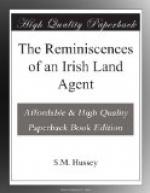Infernal machines are, after all, not confined to our own times, and this same rascally ancestor of my own appears to have had predatory habits more likely to be appreciated by his followers than by his foes.
Dingle is now a somewhat dilapidated town, but that was not always the case, for it is mentioned in my dear old friend Froude’s History of England that the then Earl of Desmond called on the ambassador of Charles V. at his lodgings in Dingle. The old records of the place would be worth diligent antiquarian research, a matter even more difficult in Ireland than elsewhere. Should all be brought to light, I fancy the part played by my family would not grow smaller.
The Husseys spread away over the county, after having their lands forfeited under both Elizabeth and Cromwell, which was the most respectable thing to suffer in those times. In the reign of Queen Anne, Colonel Maurice Hussey sold Cahirnane to the Herberts, and there is a garden still called Hussey’s Garden in the property. He built a mortuary chapel for himself on the top of a small hill just outside the gates of Muckross, where his own grave near that beautiful abbey can be seen to this day.
This Colonel Maurice Hussey resided for some time in England, and appears to have married an English lady; and it is odd that though a Roman Catholic he was trusted by the Governments of both William and Anne. There seems to have been something versatile about his rather mysterious career, the key to which may be found in the surmise that until the accession of King George he was a Jacobite at heart; which throws some doubt on his assertion in a letter that there are very few Tories—or outlaws—in Kerry, where the Whig rule was never enforced with great severity. He was, however, committed to ‘Trally jail’ (i.e. Tralee) on the fear of a landing by the Pretender, whence he wrote pleading letters, in one of which he mentions that his son-in-law, MacCartie, has taken the oaths of abjuration; and later, when released, he seems to have been disturbed at the large number of German Protestants, driven out of the Palatinate by Louis the Fourteenth, who settled at Bally M’Elligott.
Any one who rambles about Dingle and investigates the older buildings, so carefully examined by Mr. Hitchcock, will notice how frequent is the emblem of a tree; and that is a conspicuous feature of the Hussey armorial bearings.
With reference to the allusions made in Smith’s book to my ancestors, it may be pointed out that he repeated the popular tradition at the very time when the Husseys, like the rest of their fellow Catholics all over the country, were disinherited and depressed, and when he could gain nothing by doing them honour.
As for my name, it seems to have really been Norman, and to have been De La Huse, De La Hoese, and later Husee, Huse, and, finally, Hussey.
Burke in his extinct Peerage states that Sir Hugh Husse came to Ireland, 17 Hen. II., and married the sister of Theobald FitzWalter, first Butler of Ireland, and that he died seized of large possessions in Meath. His son married the daughter of Hugh de Lacy, senior Earl of Ulster, and their great-grandson, Sir John Hussey, Knight, first Earl of Galtrim, was summoned to Parliament in 1374.




